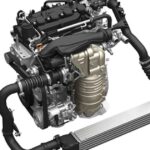When you lose control of your vehicle, it is crucial to know what to do. One key action is to release the accelerator. This simple step helps your tires regain traction and improves vehicle control. By easing off the gas, you reduce the power going to the wheels making it easier to handle slippery or unstable surfaces.
Releasing the accelerator can make a big difference in regaining control. When you are on wet or icy roads this action helps the tires reestablish their grip. It is important to remember that slamming on the brakes can make things worse. So easing off the accelerator is often the best first step in a skid or slippery situation.
Understanding Vehicle Control
Understanding vehicle control means knowing how to steer accelerate and brake safely. It is about keeping your car steady and reacting correctly to sudden changes. Good control helps you stay safe and avoid accidents.
- Definition of Vehicle Control: Vehicle control means managing steering, acceleration and braking effectively. It keeps the car safe and on course.
- Importance of Control: Maintaining control helps avoid accidents. It ensures you can respond to sudden changes in the road.
- Factors Affecting Control: Speed road conditions and driver reaction time impact control. Faster speeds and poor conditions make control harder.
- Signs of Losing Control: Unresponsive steering or skidding indicates loss of control. Recognizing these signs early is crucial for safety.
- Regaining Control: To regain control release the accelerator, steer smoothly, and brake gently. These actions help stabilize the vehicle.
The Role of Tire Traction
Tire traction is how well your tires grip the road. It helps you drive safely by allowing smooth acceleration braking and turning. Good traction prevents skids and keeps you in control. Keeping your tires in good shape is key to maintaining proper traction.
Definition
- Tire traction is the grip between your tires and the road surface.
Importance
- It helps you steerstop and accelerate safely.
- Prevents skidding and maintains vehicle stability.
How It Works
- Tread patterns channel water away and provide road grip.
- Well-maintained tires offer better traction.
Challenges
- Traction is reduced on wet icy or gravel roads.
- Poor traction can lead to loss of control.
Maintenance Tips
- Check tire tread depth and keep tires properly inflated.
- Drive cautiously in adverse conditions and consider traction aids.
Identifying Loss of Control
To identify a loss of control watch for steering issues where the wheel feels loose. Notice if the car starts skidding or sliding unexpectedly. Also listen for unusual noises like screeching and check if the vehicle struggles to stay in its lane.
- Steering Issues: If the steering wheel feels loose or unresponsive, you might be losing control. This could mean the tires are slipping or the steering system is not functioning properly.
- Skidding or Sliding: When your car starts to skid or slide it indicates a loss of traction. This can happen if the tires lose grip on the road due to slippery conditions or sudden maneuvers.
- Braking Problems: If the brakes feel spongy or do not respond as expected it is a sign that you might be losing control. This could be due to brake system issues or a loss of traction.
- Unusual Noises: Strange noises like screeching or the sound of tires skidding, can signal a loss of control. These noises often occur when tires are slipping or when the vehicle is not handling correctly.
- Difficulty Staying on Track: If your vehicle struggles to stay in its lane or veers off course it is a sign of losing control. This can happen when the tires lose grip or when you are unable to steer accurately.
Read This Blog: Natasha Fester Car Accident | Complete Detail
The Key Action: Releasing the Accelerator
Releasing the accelerator is a key action when you lose control. It helps the tires regain traction by reducing power to the wheels. This simple step can quickly help you regain control on slippery or unstable surfaces.
- Reduce Power: Easing off the gas lowers engine power to the wheels.
- Improve Traction: Helps tires regain grip on slippery surfaces.
- Stabilize Vehicle: Reduces the chance of skidding or sliding.
- Simple Step: It’s an easy and effective way to regain control.
- Essential Reaction: Important when driving on wet or icy roads.
Avoiding Sudden Braking
Avoiding sudden braking is important when you are losing control. Slamming on the brakes can make your tires lock up and cause skidding. Instead brake gently to maintain better control and stability.
- Avoiding Sudden BrakingDon’t Slam the Brakes: Slamming on the brakes can lead to skidding, especially on slippery surfaces. It reduces tire traction and can make the situation worse.
- Brake Gently: Apply the brakes smoothly and gradually to maintain control. This helps prevent the wheels from locking up and keeps the car stable.
- Focus on Smooth Stops: Gradual braking allows you to stop more smoothly and helps the tires keep grip on the road. It is important to avoid sudden stops that can disrupt traction.
- Use Brakes Wisely: Only apply hard braking in true emergencies. In most situations, controlled and gradual braking will keep you safer and more in control.
Steering Smoothly to Regain Control
Steering smoothly is crucial when you are trying to regain control of your vehicle. Turn the wheel gently in the direction you want to go. Avoid jerky movements, as they can worsen the skid. Smooth steering helps realign your car and restore traction. It is about guiding your vehicle back on track without overreacting.
When you are on slippery roads, smooth steering becomes even more important. Gradually adjust the wheel to keep your car stable. Abrupt turns can cause more skidding and loss of control. By steering smoothly, you help your tires grip the road better. This technique is key to safely navigating through challenging conditions.
Preventing Loss of Traction
To prevent loss of traction keep your tires in good condition by checking tread depth and inflation. Drive slowly and avoid sudden movements, especially in poor conditions. Regular maintenance and careful driving help maintain better grip on the road.
- Maintain Your Tires: Check tread depth and keep tires properly inflated.
- Drive Slowly: Reduce speed in poor road conditions.
- Avoid Sudden Moves: Make gradual turns and gentle accelerations.
- Use Traction Aids: Consider snow chains or special tires for tough conditions.
- Adjust Driving Habits: Adapt to weather and road conditions to stay safe.
The Role of Technology
Technology helps improve vehicle control with features like traction control and stability systems. These systems adjust power and brakes to prevent skidding. While they aid in safety, they do not replace careful driving.
Traction Control Systems (TCS):
- TCS helps prevent wheel slip by reducing engine power or applying brakes to specific wheels. This keeps the tires from losing traction, especially on slippery surfaces.
Anti-lock Braking System (ABS):
- ABS prevents the wheels from locking up during hard braking. This allows you to maintain steering control and avoid skidding, helping you stay on course during sudden stops.
Electronic Stability Control (ESC):
- ESC helps maintain vehicle stability by automatically applying brakes to individual wheels. It corrects oversteering or understeering, helping the driver regain control when the vehicle starts to skid.
Adaptive Cruise Control:
- This system automatically adjusts your car’s speed to maintain a safe distance from the vehicle in front. It helps keep a steady pace on highways and reduces the need for manual speed adjustments.
Automatic Emergency Braking (AEB):
- AEB detects potential collisions and automatically applies the brakes if a crash is imminent. This technology helps reduce the severity of accidents or prevent them entirely by intervening when the driver might not react in time.
Frequently Asked Question
What should you release to re-establish vehicle control?
Release the accelerator to reduce power to the wheels. This helps the tires regain traction and improves control. It is a key step in regaining stability.
Why is releasing the accelerator important?
Releasing the accelerator reduces wheel spin and allows the tires to grip the road better. It helps you regain control, especially on slippery surfaces.
When should you release the accelerator?
Release the accelerator if you start skidding or lose traction. It is especially important on wet, icy, or gravelly roads.
Can you brake hard while losing control?
No, braking hard can make things worse by causing the tires to lock up. It’s better to release the accelerator and brake gently if needed.
How can technology help with vehicle control?
Technology like traction control and stability systems adjust power and braking to help maintain traction. While helpful it is important to drive carefully and not rely solely on these systems.
Conclusion
To regain vehicle control and tire traction the key action is to release the accelerator. By easing off the gas, you reduce power to the wheels allowing them to regain grip on slippery surfaces. This simple step can make a big difference in stabilizing your vehicle during a skid or when driving on challenging roads.
While releasing the accelerator is crucial it is also important to steer smoothly and brake gently if needed. Avoid sudden movements as they can worsen the situation. Keeping your tires well-maintained and adjusting your driving to match road conditions are also essential for preventing loss of traction. With these practices you can handle unexpected situations more effectively and drive safely.







